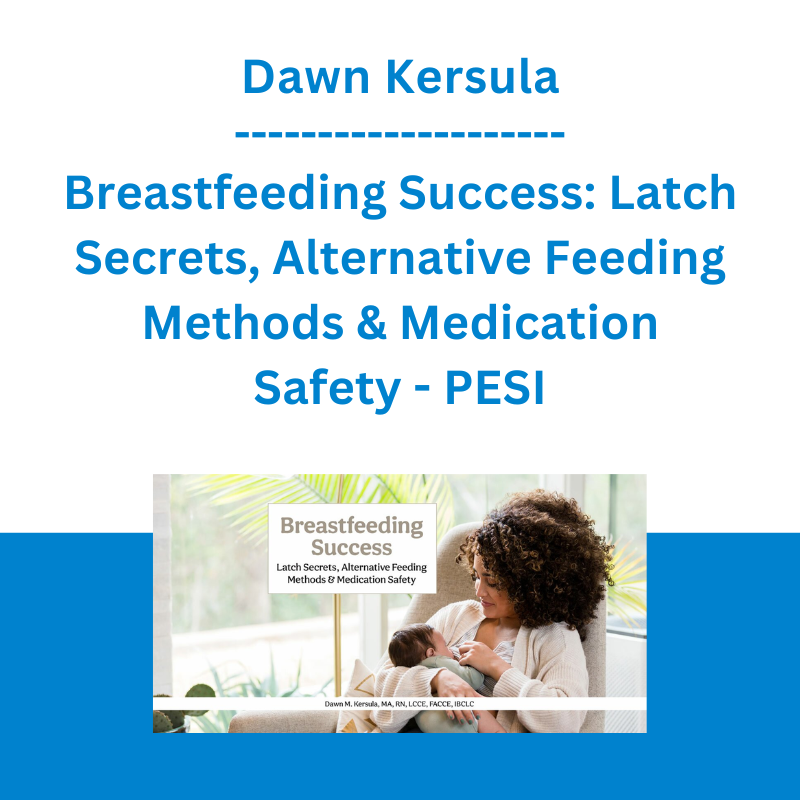*** Proof of Product ***
Exploring the Essential Features of “Dawn Kersula – Breastfeeding Success: Latch Secrets, Alternative Feeding Methods & Medication Safety – PESI”
Speaker: Dawn M. Kersula, MA, RN, IBCLC, LCCE, FACCE
Duration: 5 Hours 49 Minutes
Format: Audio and Video
Copyright: Aug 30, 2022
Media Type: Digital Seminar
Description
Over 80% of mothers say they want to breastfeed their babies – but by the time they leave the hospital almost 20% of those babies have already been given formula. Can we change that metric? Why do babies seem to refuse the breast, and what help can we offer?
Parents can feel confused, frustrated, and overwhelmed. They report that information has not been consistent amongst the nurses helping them. How can we change that? What can we do to help hit the reset button for babies who are neurologically disorganized and fighting the breast?
Speaker
Dawn M. Kersula, MA, RN, IBCLC, LCCE, FACCE
Dawn M. Kersula, MA, RN, IBCLC, LCCE, FACCE, is a lactation specialist and perinatal educator who founded/continues to staff the outpatient lactation clinic at a hospital in Vermont. She has worked with birthing and breastfeeding families for more than 30 years. Respected for her expertise in the field, Dawn is a requested presenter at international childbirth conferences and locally continues to coordinate her hospital’s perinatal education programs/support groups. As president of the Vermont Lactation Consultants Association, she works closely with the Vermont State Breastfeeding Network to offer training opportunities throughout the state and has had the opportunity to impact change through several legislative initiatives that have resulted in pro-breastfeeding legislation in Vermont.
Dawn’s passion and commitment are evidenced through her certification as a Lamaze Certified Childbirth Educator (LCCE), active involvement with ILCA (International Lactation Consultants Association), and appointment as a fellow with the American College of Childbirth Educators (FACCE). Her master’s research focused on PTSD following traumatic childbirth experiences and, in her role as a perinatal psychologist, she continues to have a special interest in the developmental transition to motherhood. To her credit, Dawn has published over 30 articles pertaining to the specialty of breastfeeding.
Speaker Disclosures:
Financial: Dawn Kersula has an employment relationship with Lactation Education Consultants. She receives a speaking honorarium and recording royalties from PESI, Inc. She has no relevant financial relationships with ineligible organizations.
Non-financial: Dawn Kersula is an author for Baby Steps Blog.
Objectives
- Apply the BASICS of breastfeeding assessment to deepen latch.
- Evaluate positioning for breastfeeding couplets based on infant preference and need.
- Analyze the hierarchy of pharmacokinetics to evaluate the safety of medications during breastfeeding.
- Determine available antidepressants for use during the postpartum and their safety for breastfeeding couplets.
- Appraise new research suggesting the role of insulin in milk production.
- Investigate D-MER and proposed role of oxytocin and dopamine in its etiology and severity.
- Apply an understanding of states of infant consciousness to feeding rhythms.
- Design a care plan utilizing feeding alternatives for babies struggling with latch in the first days postpartum.
Outline
Breastfeeding Latch, Suck & Positioning
- What is a good latch?
- The best position is the one that works
- Studies show families want hands-on, practical help with latch and positioning
- Physiologic breastfeeding (also called Baby-Led) encourages babies and moms to follow their instincts
- Steps to an effective feed
- BASICS can help staff and families assess and improve latch
- B = Belly to Belly
- A = Alignment
- S = Space
- I = In Close
- C = Cheeks and Chin
- S = Sucking and Swallowing
- What about babies who “fight the breast”?
- Assist with positional stability and teach the parent WHY the baby does what they do
- Maternal and infant conditions can affect latch and positioning
- Babies come with a history
- The role of birth, stimulation, medications
- Gestational age
- Neurologic disorganization
Self-Efficacy
- Pathways to self-efficacy
- Performance accomplishment
- Vicarious experiences
- Verbal persuasion
- Distressed behavior
- Babies who have been repeatedly pushed forcefully to the breast can learn it’s a place of discomfort, not comfort
- Feed in an alternate way
- Re-establish trust
- Back to the breast: Make it feel safe
- STS or not: “How do we fit together?”
- Mother keeps calm, follows infant lead
- Use your expertise only when needed
- GLOW authors suggest
- On days 2-3 share info about feeding cues and latch
- Supports lactogenesis II and the making of milk
- Supply will “take off like a rocket”
Alternative Feeding Methods
- What is normal weight loss?
- Start with hand expression
- Choose a safe way to get the milk into the baby – Global Media video
- Safe use of nipple shields
- Safe use of paced bottle feeding
- Push the reset button
- Teach parents about infant states of consciousness
Medication Safety
- Considerations for availability
- Molecular weight
- Lipid solubility
- Excretion of drugs including half life
- Oral bioavailability
- Timing in lactation
- Translating the theory into real life
- Hale’s Lactation Risk Categories
- Antidepressants
- Cannabis
- Cigarettes
- Alcohol
- SARS-COV2 vaccines and therapies
- Hormonal contraceptives
- Resources
- Infant Risk Center
- PLLR labeling
- References in print
Anatomy and Physiology Update
- 4-18 Ductal openings (previously thought 15-20)
- The ducts branch closer to the nipple – the lactiferous sinuses do not exist
- Ducts can be just below the skin surface, making them easily compressible
- Most glandular tissue is found within 30 mm (~1.2 inches) of the nipple
- Montgomery Glands are now called Areolar Glands
- Lactogenesis I (Secretory Differentiation)
- Lactogenesis II (Secretory Activation)
- Protracted nipples
- Inverted nipples (Grade 1 – 3)
- Baseline prolactin levels
- The role of insulin
- Is oxytocin always our friend?
- New research on Dysphoric Milk Ejection Reflex
Target Audience
- Nurses
- Nurse Practitioners
- Clinical Nurse Specialists
- Doulas
- Midwives
- Clinical Nurse Specialists
- Lactation Consultants
- Childbirth Educators
Please see the full list of alternative group-buy courses available here: https://lunacourse.com/shop/










 Alphashark - The AlphaShark SV-Scalper
Alphashark - The AlphaShark SV-Scalper